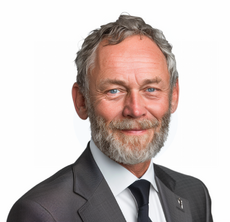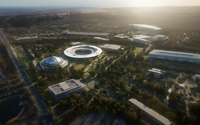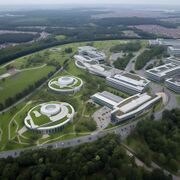User:Belfras/SandboxSpace2
New datasheet
Sodalitas Cosmos Agencia (latin) | |
 Logo | |
 Meatball | |
| File:JSA Membership.png Member states shown in dark blue | |
| Abbreviation | SCA (latin) |
|---|---|
| Formation | 1 August 1968 |
| Type | Space agency Aeronautics research agency |
| Headquarters | Thessalona, Belfras |
Membership | Member states: |
Official languages | latin (official) |
Director-General | Deckard Gleise |
Deputy Director-General | XXXX |
The Joint Space Agency (JSA) is an international organization dedicated to space exploration, scientific research, and technological innovation. Established in 1968 by Belfrasian Federation, the Latin Empire, and the Republic of Sante Reze, the JSA was founded to combine the resources and expertise of its member nations in pursuit of advancing humanity’s reach into space. Having been created following significant space infrastructure development by the tri-national space alliance, the agency utilised these advancements to achieve its first major milestone in 1973 with a series of successful moon landings, firmly establishing itself as a leader in the exploration of space.
Over the decades, the JSA expanded its membership to include nations from around the world, evolving into the largest and most inclusive space agency in existence. Its mission is to foster international cooperation, promote the peaceful use of outer space, and drive innovation to address both scientific and practical challenges.
The agency operates under the guidance of a Space Council, which is composed of representatives from each member nation. This governing body oversees the agency’s strategic priorities and ensures equitable collaboration among members. The JSA maintains facilities across its member nations, including research centers, training programs, and engineering hubs. Its primary launch facility, however, is located in Sante Reze, serving as the heart of its space exploration operations.
The JSA is at the forefront of humanity’s presence beyond Earth, operating a functional partially-manned moon base that supports scientific research and serves as a staging ground for future missions. With plans to conduct crewed missions to Mars by 2035, the agency continues to lead efforts to expand humanity’s understanding and utilization of outer space.
It's primary spaceport is the Eporte KeParaguasure Okeere (EKPO) (International Port of Paraguasurun) located in Sante Reze. JSA also conducts space launches at the Cape Castille Space Centre located in Gristol-Serkonos for satellites going into polar orbit. It previously operated from Galileo Space Center in Belfras until it was closed in 1972.
History
In the late 1950s, Belfras, Latium, and Sante Reze united their space exploration efforts, forming the foundation of the Joint Space Coalition (JSC). Each nation brought its expertise and institutions to the partnership: Belfras through the Space Technology Aeronautical Research Agency (STAR), Latium through Cursus Astrum (CA), and Sante Reze through the Kimiyye Hendreri Ofurufu Populeris (KHOP). Operating from the Galileo Space Center, the JSC achieved a series of groundbreaking milestones that propelled humanity into space and solidified their cooperative venture.
The Archytas Tutso Program marked the JSC’s first step into space exploration. These missions were designed to test the feasibility of human spaceflight and validate essential systems. In 1961, XXXX of XXXX became the first astronaut launched from the Galileo Space Center, riding the Aurora 1 capsule on a 15-minute suborbital flight. The program continued with enhanced suborbital missions, refining spacecraft systems and laying the groundwork for orbital missions.
Building on these early successes, the JSC launched the Centaur Program, focusing on advanced space operations, including orbital flights, docking, and extravehicular activity (EVA). In 1964, Centaur 1 completed the JSC’s first crewed orbital mission, with XXXX of Latium and XXXX of Belfras aboard. This mission demonstrated the capability for sustained operations in space. Milestones of the Centaur Program included the first docking in 1965, the historic EVA by XXXX of Sante Reze in 1966, and the 14-day orbital mission of Centaur 7 in 1967, which proved the durability of life-support systems for long-term missions.
Throughout these programs, the collaboration between STAR, CA, and KHOP showcased the power of international unity. Engineers, scientists, and astronauts worked together at the Galileo Space Center, sharing expertise and fostering a spirit of mutual respect and camaraderie. These achievements paved the way for more ambitious missions.
By 1968, the success of the Archytas Tutso and Centaur programs led to the formation of the Joint Space Agency (JSA), consolidating the resources and expertise of all three nations under one organization. This marked the beginning of a new era, with the JSA focusing on lunar exploration and more complex space missions.
The accomplishments of the early Joint Space Coalition remain a testament to international collaboration and ingenuity. From the experimental flights of Archytas Tutso to the orbital breakthroughs of Centaur, the program laid the foundation for the bold exploration of space and demonstrated what humanity could achieve when united by a common goal.
Creation
In 1954, the Space Technologies and Aeronautical Research (STAR) organization in Belfras began collaborating with Cursus Astrum (CA), the national space agency of Latium, to advance space exploration. This partnership built upon Belfrasian research into supersonic rocket planes, initially driven by the Social War and heightened tensions with northern Elatia. Operating out of the Galileo Space Center in southern Belfras, STAR and CA worked jointly on several groundbreaking projects, including one of the earliest manned spaceflights. Their efforts culminated in the development of the Centaur project, which sought to refine key spaceflight technologies such as rendezvous, orbital maneuvering, and docking. During the Centaur project, the Sante Reze space agency, Kimiyye Hendreri Ofurufu Populeris (KHOP), joined the partnership through a technology-sharing agreement. This collaboration evolved into resource pooling and joint operations under a brief Confederation of the three agencies.
By 1965, STAR, CA, and KHOP began initial planning for an ambitious space exploration program that aimed to expand orbital capabilities and pursue a potential moon landing. This initiative, which eventually became the !Apollo program, showed significant promise, garnering interest from other agencies such as the Arthuristan Commonwealth Aerospace Bureau (CAB). The program’s goals also helped secure additional government funding for the participating agencies.
To streamline operations and ensure effective resource allocation, the founding nations—Belfras, Latium, and Sante Reze—proposed the creation of a centralized space agency. The concept envisioned a body led by scientists and astronauts, with political oversight limited to a Representative Council. This vision materialized on August 1, 1968, with the signing of an agreement to establish the Joint Space Agency (JSA). Two months later, on October 14, Arthurista formally joined as the fourth signatory.
Project Diocles
The Diocles Project was a groundbreaking hypersonic research program undertaken by the Belfrasian Federation in the 1950s. Born out of the geopolitical shifts following the Social War—a 1940s conflict where Belfras supported Latium in defeating pro-socialist forces—the project represented a pivot from military dominance to technological innovation. Conducted under the auspices of the Space Technology Aeronautical Research Agency (STAR), the program explored the extremes of high-speed atmospheric flight, achieving milestones that would shape the future of aerospace and space exploration.
Named for the ancient physicist Diocles, the program focused on developing rocket-powered hypersonic vehicles to study the effects of extreme speed and altitude on aerodynamics, propulsion, and materials. Early successes included the DHV-1, which in 1952 achieved Mach 3 under the command of test pilot Darius Kolt, setting a benchmark for controlled high-speed flight. By 1954, the DHV-2 had reached Mach 5, with pilot Anois Phillipe pioneering research into thermal stresses and heat-resistant alloys. The program’s pinnacle came in 1956, when the DHV-3 climbed to an altitude of 85 kilometers, skimming the edge of space and demonstrating aerodynamic control in near-vacuum conditions.
The Diocles Project’s achievements not only positioned Belfras as a leader in hypersonic research but also laid the groundwork for international collaboration. By the late 1950s, inspired by its wartime alliance with Latium and growing cooperation with Sante Reze, Belfras sought to expand its scientific ambitions. The successes of the Diocles Project became a cornerstone for discussions that led to the formation of the Joint Space Coalition (JSC) in 1958, uniting Belfras’s STAR, Latium’s Cursus Astrum (CA), and Sante Reze’s Kimiyye Hendreri Ofurufu Populeris (KHOP) in a shared pursuit of space exploration.
Project Archytas
The Archytas Tutso Program was the first human spaceflight initiative conducted by the newly-formed Joint Space Agency (JSA), a collaboration between Belfras, Latium, and Sante Reze, established in 1958. Named after the ancient mathematician Archytas, the program aimed to prove the feasibility of human spaceflight through a series of suborbital missions, laying the foundation for future orbital exploration. Operating out of the Galileo Space Center, the program marked a significant milestone in both technological innovation and international cooperation.
Using the compact Tutso capsule mounted atop a Tandem Aether Rocket, the program tested key systems such as life support, guidance, and capsule recovery. In 1961, Aurora 1, piloted by Sante Reze astronaut XXXX, achieved the first human suborbital flight, reaching 190 kilometers in altitude. Subsequent missions, including Aurora 2 in 1962 with Latium’s XXXX and Aurora 3 in 1963 with Belfras’s XXXX, refined systems critical to human spaceflight. These missions introduced improved guidance, advanced telemetry, and prototype heat shields, pushing the boundaries of high-speed reentry technology.
By the conclusion of the Archytas Tutso Program in 1963, the JSA had not only proven the viability of human spaceflight but also laid the groundwork for its next phase: the Centaur Program, focusing on sustained orbital missions. The program symbolized the potential of international collaboration, uniting expertise and resources from three nations to achieve a shared vision. Its successes remain a pivotal chapter in the history of space exploration, showcasing the ingenuity and unity that propelled humanity’s first steps toward the stars.
Project Centaur
Project Selene (1968-2004)
As the cooperation between nations within the Joint Space Agency grew it was becoming more evident that a truly unilateral project was required.
Modern spaceflight programs
Pioneer Program (1986-present)
Unity Space Station (1998-present)
Pathfinder Program (2014-present)
Member states and budget
| Member state | JSA convention | Representative | National programme | Contributions | ||
|---|---|---|---|---|---|---|
| Test1 | Test2 | Test3 | ||||
| Full member states | ||||||
| TBD | TBD | TBD | 1 | 2 | 3 | |
| 1 August 1968 | Odoacer Bursio | STAR | 1 | 2 | 3 | |
| TBD | TBD | TBD | 1 | 2 | 3 | |
| TBD | TBD | TBD | 1 | 2 | 3 | |
| 20 October 1971 | TBD | SARA | 1 | 2 | 3 | |
| 1 August 1968 | TBD | CA | 1 | 2 | 3 | |
| TBD | TBD | TBD | 1 | 2 | 3 | |
| TBD | TBD | TBD | 1 | 2 | 3 | |
| TBD | TBD | TBD | 1 | 2 | 3 | |
| TBD | TBD | TBD | 1 | 2 | 3 | |
| TBD | TBD | TBD | 1 | 2 | 3 | |
| 6 October 1978 | TBD | NARA | 1 | 2 | 3 | |
| 1 August 1968 | TBD | KHOP | 1 | 2 | 3 | |
| TBD | TBD | TBD | 1 | 2 | 3 | |
| 8 April 1972 | TBD | DARD | 1 | 2 | 3 | |
| TBD | TBD | TBD | 1 | 2 | 3 | |
Applicant States
Suspended States
Enyama
Following the outbreak of the Enyaman Civil War on 19 September 2019 the Joint Space Agency formally announced that as no clear government existed that the membership to the Agency would be immediately suspended until otherwise stated. Since this decision, which was made in December that same year, no other information has come to light regarding the suspension of membership. It is known, however, that many employees of the JSA that are Enyaman in nationality have since relocated permanently to either Belfras or Sante Reze.
Collaboration
International Aeronautical Union
The partnership between the Joint Space Agency (JSA) and the International Aeronautical Union (IAU) represents a significant collaboration in the field of space exploration, initiated in XXXX. This alliance has evolved over the decades to achieve numerous milestones in lunar exploration and now aims to tackle exciting new challenges ahead, including the development of a new international space station. The collaboration between the JSA and IAU began in XXXX, driven by a shared vision to advance human knowledge and technological capabilities in space. Recognizing the potential benefits of joint efforts, both agencies forged a strategicalliance that allowed them to combine their expertise, resources, and ambitions.
One of the hallmark achievements of this partnership has been the successful participation of the IAU in several moon landings conducted by the JSA as part of it's Pioneer program. Through this cooperation, IAU has contributed its vast scientific knowledge and expertise in aerospace engineering, which has enhanced mission planning, technology development, and astronaut training. These joint expeditions to the Moon have allowed both organizations to conduct scientific research, gather precious data, and perform experiments that have deepened our understanding of lunar geology and potential resources.
The ongoing partnership between the Joint Space Agency and the International Aeronautical Union stands as a testament to the power of collaboration in advancing the understanding of space. Through the shared history of successful lunar missions and a joint commitment to the creation of new infrastructure and future cooperation, both agencies exemplify how cooperation can lead to groundbreaking discoveries and forge pathways for future advancements in space exploration. This partnership not only enhances scientific research but also empowers nations to work together towards common goals, inspiring future generations to reach for the stars.
Management
As planned in the Conventions two organs are defined which work together to run the Joint Space Agency; the Space Council and the Director-General. The Space Council is composed of Representatives of the member states which meets as required at Representative or delegate level. The Director-General is appointed by the space council and serves at their leisure and in their duty represents the JSA in it's acts and executes policy defined by the Space Council. The Council has set-up subordinate bodies to be assisted in it's duties. Each of the Committees and Boards take decisions, make recommendations or are kept informed according to the amount of powers invested in them by the Council in their given area of responsibilities. Each Member States nominates its representation to the boards and committees; these delegates are often accompanied by experts.
Space Council
The primary role of the Space Council is to establish the direction and policy of the Joint Space Agency. Representatives of the space council meet every two to three years to assess current challenges, opportunities, and technological advancements in space exploration and then decide on the agency's priorities and initiatives for the forthcoming period. The Space Council is also responsible for overseeing the implementation of these policies, and to this end they appoint a director-general who will act as the executive officer for the agency and ensure that the agency's activities align with the established goals and regulatory guidelines. Oversight over these activities are conducted through an executive committee whose responsibilities include conducting oversight over all established activities and programmes, over the different divisions and support services, and finally over the director-general and administrative staff themselves.
Representatives in the Space Council will be charged with appointing teams of experts to their staff and assigning delegates to attend lesser meetings which are focused on specific programmes and initiatives. These delegates and meetings allow for focused discussions, expert contributions, and a more agile decision-making regarding particular projects by avoiding unnecessary administrative efforts. As stated in the conventions, the contributions of the Representatives as representatives of the members states promotes international cooperation. This collaboration fosters a unified approach to address global challenges in space research, technological advancement, and policy regulation, furthering the peaceful exploration and utilization of outer space.
Director-General
The Director-General (DG) of the Joint Space Agency is the Chief Executive Officer over it's actions and is responsible for the definition, implementation, and development of the agency's space infrastructure and activities. The office is also responsible for ensuring all actions taken by the JSA align with policy and regulatory guidelines set by the Space Council. As the Chief Executive Officer, the Director-General is charged with overseeing the programmes and directives which control and maintain the agency's launchers, satellites, space stations and current lunar exploration.
The key responsibilities for the office include developing and implementing the JSA's long-term vision and strategies to advance the infrastructure and exploration of space. They ensure that the agency's activities align with policy and regulations set out by the Space Council and to this goal oversees the day-to-day operation of the JSA, managing a diverse workforce of scientists, engineers, and administrative staff. They are responsible for ensuring that the budget is allocated appropriately, ensuring that future financial planning is carried out effectively and on time.
While the Space Council sets out policy and regulations, the DG has the responsibility of forming space policy under those guidelines and cooperating with the Space Council to ensure that, if necessary, the policy and regulations are altered to meet new conditions as necessary. They hold meetings with national governments within and outside of the JSA to promote international cooperation and ensure that the dialogue on the exploration of space is continued to be carried out. They are also the spokesperson for the JSA, promoting the projects and achievements of the agency to the public and media. In line with the new convention of the young persons outreach signed 1996, the DG is also responsible for ensuring that future generations are inspired and that education facilities exist to educate the next generation of scientists, astronauts, and pioneers.
Finally, the Director-General utilises an administrative structure of Operations Directors, Facilities Directors, and Project/Programme Directors to run the divisions and other bodies within the agency. In the event of an emergency, the DG has the ability to override the Space Council's guidelines and policies if it is reasonable to do so in order to mitigate impacts on ongoing projects and missions.
Since 2018 the Director-General has been Dr. Deckard Gleise of the Belfrasian Federation. Prior to his appointment by the Space Council, he had been the Operations Director of Technology, Engineering and Quality (otherwise known as the Director of Technology) and had previously been responsible for the implementation of new technologies at EKPO Space Port.
Offices and Facilities
The offices and facilities operated by the Joint Space Agency are distributed among various countries and areas. The primary locations, such as the primary headquarters, launch facility and research campus are separated among the three founding members in an arrangement that dates back to the initial founding of the agency.
- The JSA administrative headquarters in Thessalona, Belfras. This location houses the leadership of the Joint Space Agency, the meeting location for the Space Council, and also houses it's astronaut corps, security forces, and public relations office.
- XXXX Research Center in Latium, this is the largest facility dedicated to furthering research and technological developments by the agency.
- Ekporte KeParaguasure Okeere (EKPO) Space Center in Sante Reze. This is the agency's primary launch facility.
- Facilities owned and operated by member-state space agencies but have close collaboration with the JSA include;
- Cape Castille Space Port in Gristol-Serkonos, this is owned and operated by SARA, but has been responsible for JSA polar launches since the 1980s.
- National Space Training center in Belfras. This has trained new astronauts since the 1960s and is responsible for training the initial astronauts that the JSA utilised.
| Field Center | Primary Location | Facility Director | |||||
|---|---|---|---|---|---|---|---|
| JSA Headquarters | Belfras | Lydon Orinis | |||||
| EKPO Space Port | Sante Reze | TBD | |||||
| XXXX Research Facility | Latium | TBD | |||||
| Collaborative facilities | |||||||
| Cape Castille Space Port | Gristol-Serkonos | Dr. Adélaïde Villeneuve | |||||
| National Space Training Center | Belfras | Daud Winso | |||||
JSA's headquarters campus in Belfras
EKPO, the JSA's main launch site in Sante Reze
XXXX research center in Latium
Cape Castille Space Centre, JSA's polar launch site in Gristol-Serkonos












